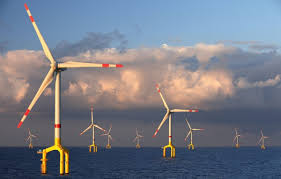Germany seeks to increase its offshore wind power capacity five times the amount it currently holds by 2040 as part of its plan to wean the country off fossil fuels. The German Cabinet on Wednesday agreed on a bill that would set a goal of 40 Gigawatts of installed offshore wind power capacity in 20 years, from about 7.5 Gigawatts at present. It also raised the goal for 2030 from 15 Gigawatts to 20. Peter Altmaier, the Economy Minister said the new offshore wind target for 2030 would assist Germany to reach its goal of meeting 65 per cent of its gross electricity consumption with renewable energy in the next ten years. The longer-term goal would provide businesses and coastal regions with planning certainty, he added. The country’s offshore wind generation is greatly surpassed by the number of turbines installed on land, which already have a combined capacity of 54 Gigawatts.
Also Read: UK to build world’s largest hydrogen electrolysis plant in Germany.
Angela Merkel, the German Chancellor recently mentioned that she fully supports the goal of making Europe ‘climate neutral’ by 2050 to keep global warming in check. This ambitious target will require the world’s biggest economic bloc to phase out the use of fossil fuels. Because renewable energy generated by wind and solar plants changes so often depending on the weather, one proposal is to use the excess electricity to produce hydrogen that can be easily stored, transported and burned without releasing greenhouse gases.
Municipal utility association VKU encouraged the amendment in principle but criticised that it failed to prevent “speculative bidding” in project tenders. Only big companies would be able to present zero-support bids without putting their financial survival at stake, VKU head Ingbert Liebing argued. He stated further that bids in project tenders should be based on actual electricity production costs, rather than on power price forecasts, which could, for example, be done with so-called contracts for difference that are tied to a fixed price level in advance.

